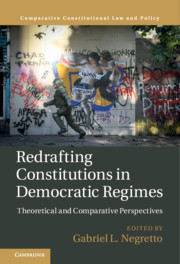Book contents
- Redrafting Constitutions in Democratic Regimes
- Comparative Constitutional Law and Policy
- Redrafting Constitutions in Democratic Regimes
- Copyright page
- Dedication
- Contents
- Tables
- Contributors
- Acknowledgments
- 1 New Constitutions in Democratic Regimes
- Part I Conceptual, Normative, and Empirical Issues
- 2 Constitution Making through Law
- 3 Expanding Revision Clauses in Democratic Constitutions
- 4 Courts and Constitution Making in Democratic Regimes
- 5 Replacing Constitutions in Democratic Regimes
- Part II Case Studies
- Index
- References
3 - Expanding Revision Clauses in Democratic Constitutions
from Part I - Conceptual, Normative, and Empirical Issues
Published online by Cambridge University Press: 29 August 2020
- Redrafting Constitutions in Democratic Regimes
- Comparative Constitutional Law and Policy
- Redrafting Constitutions in Democratic Regimes
- Copyright page
- Dedication
- Contents
- Tables
- Contributors
- Acknowledgments
- 1 New Constitutions in Democratic Regimes
- Part I Conceptual, Normative, and Empirical Issues
- 2 Constitution Making through Law
- 3 Expanding Revision Clauses in Democratic Constitutions
- 4 Courts and Constitution Making in Democratic Regimes
- 5 Replacing Constitutions in Democratic Regimes
- Part II Case Studies
- Index
- References
Summary
In democratic regimes, formal constitutional change is an important opportunity for the people to express their sovereign power and improve their constitutional system of government. But how should this process be designed in order to live up to this promise? Democratic theory prioritizes an open process that allows the people to bypass entrenched elites and restructure their democratic orders through extraordinary institutions. Yet this open process can create an even larger problem: That a self-interested majority faction captures these extraordinary institutions and uses constitutional law to entrench itself. This problem of faction is best solved through legal regulation and institutional checks and balances. Looking to comparative experience, this chapter will examine ways to balance the need for openness and regulation in democratic constitution making. This analysis in turn can help us design expanded revision clauses in democratic constitutions that will allow constitutions to improve the process of constitution making.
- Type
- Chapter
- Information
- Redrafting Constitutions in Democratic RegimesTheoretical and Comparative Perspectives, pp. 53 - 77Publisher: Cambridge University PressPrint publication year: 2020
References
- 2
- Cited by

